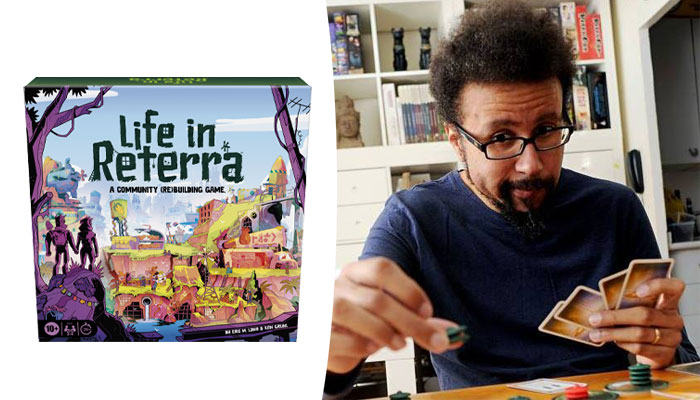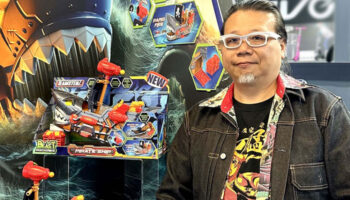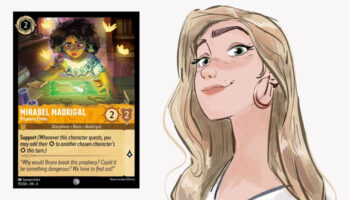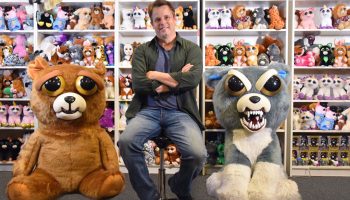Prolific game designer Eric Lang takes us inside Hasbro’s Life in Reterra

“We gave ourselves a complexity budget in the design process”: Eric Lang on crafting an accessible mass market game, with depth…
Eric, I’m delighted to tie-in. To kick us off, what set you on the path to a career in game design? Was it always on the cards?
Sort of, yeah! But it took me a while to notice. I’ve been playing and even designing – modding – games since I was eight years old visiting my grandmother in Germany. But I spent most of my teens wanting to be a rock star. I settled for musician, but it was D&D – and later Magic: The Gathering – that later in life reminded me that gaming was where my professional heart lies.
We’re chatting today because you’ve recently teamed up with Hasbro on the exciting Life in Reterra. For anyone yet to see the game, how would you pitch it?
Life In Reterra is a post-apocalyptic but cozy strategy tiling game for two to four players. It takes like 30 minutes to play and you need to know almost nothing about games to start playing it.
I like “post-apocalyptic but cozy”. Can you tell us about the theme?
Yes! Not long from now, the world as we know it is an overgrown memory. Though the world has changed, we’ve changed with it, using anything we can find to build a new way of living. It’s up to each player to build a community of their own! You need to know how to build a community, put buildings on it, populate it with people, get lots of points – and there’s like more than 10,000 ways to play… It’s unbelievable.

So each player can craft their own approach to creating a community?
You’re not just building ‘a community’, you’re really building YOUR community. It develops the way you want to, and the emerging strategies really feel like your own – all while not overwhelming you with choices and boring upkeep. We developed the game so closely along with the theme and made sure that the different building combinations contributed to an overall game feeling that players could really latch on to.
And how did this idea come about?
Life in Reterra comes from a decades-long ambition to delivery “the D&D moment” to a new generation of board gamers. That is, provide an easily accessible game that pierces the veil and unlocks a wider world of what games can be… To folks who have never been exposed to our hobby.
Did Hasbro feel like a great fit for that from the off?
Hasbro absolutely felt like a great fit from the beginning. From maintaining a huge portfolio of games that everyone loves and being the world’s largest game developer, I knew from the beginning that Hasbro was the best partner to bring this new innovative game to the market.
Honestly, it was Tanya Thompson who came to me a few years ago and said: “We’re ready.” I knew exactly what she meant, and this was the game. It really was lightning in a bottle, and working with the team at Hasbro has been amazing. You can really feel the passion and love that went into every aspect of Life in Reterra.

Fantastic. Now, I’ve seen you describe the game as being on a ‘knife edge of opposing design principles’ in how it’s accessible, while also boasting strategic depth. How do you thread that needle? It sounds like a tough tightrope to walk!
To me, Life in Reterra is the gateway to a game that is way bigger than the box… There are 11,000-something combinations in the game; you can play it over and over and over again. There are no two games that will ever be the same, but with a rule set that is easy enough for anybody to get. I love how this game has a metric ton of depth, but you can explain very quickly in plain English. It’s got the variety and replayability of the top hobby market games but doesn’t feel overly “geeky.” It works the way you expect to, and the delicious complexity sneaks up on you.
We achieved this, I believe, by designing a game that appealed to our hardcore gamer sensibility, but removed all of our presupposed game design knowledge, making sure that we were always aware of where the complexity was being added. We literally gave ourselves a complexity budget in the design and development process.
A complexity budget – great idea. You worked with another prolific game designer – Ken Gruhl –on this. How did that collaboration with Ken work?
Ken and I have been working together for years, ever since I signed his game Foodies for CMON back in 2017. We have great chemistry and complement each other well. For my entire career, I’ve dreamed about making a strategy game with endless variety, depth and discovery – but for a broad audience. Life in Reterra was that game from almost the very first prototype. Partnering with Ken was a no-brainer, as his vast experience with mass market and sharp eye for approachability without sacrificing depth
You’ve been involved with lots of designer collaborations over the years. What do you feel is the key to a successful creative collaboration?
It’s almost identical to being in a band. Chemistry, chemistry, chemistry. I’ve worked with so many talented people in my career, and that raw shared energy is the most important ingredient to me. Do we get each other excited? Do we look forward to design sessions? Do the games we create really feel like something neither of us would have done?

You’ve worked across both hobby and the mass market… Do they feed each other when it comes to design inspiration? For example, does the experience of designing Anarchy Pancakes inform anything about how you approach something like Mass Effect: The Game?
Absolutely. Working in mass market for years helped me recalibrate my tolerance for “homework”.
“Homework” being?
The type of set-up, administrative and puzzly complexity that some hardcore gamers love but most gamers do not. Life in Reterra felt like a return to my roots. Focusing more on hook and core fun promises.
I’ll always have hobby games in my DNA; and I’m addicted to media that promises both hours of exploration and almost relaxing, mediative gameplay once you’ve reached an approachable level of mastery. This is my sweet spot, and I think both broad market games and hobby games can offer this… It’s just a matter of, can we meet the audience where they are?
Eric, this has been great. Before we start to wrap up, what fuels your creativity? What helps you have ideas?
This probably sounds braggy, but creativity is never an obstacle for me. I get excited and inspired by literally anything, almost to the point where it’s a problem. It’s an ADHD thing; I’m always connecting unrelated dots – and honestly need to spend most of my energy and practice staying focused on one thing at a time.
Last question! You’ve created some huge blockbuster titles in your career, but what do you think is your most underrated design?
I’m not sure about underrated, but I think Arcane Academy (Third World Studio, co-designed with Kevin Wilson) and Victorian Masterminds (CMON, co-designed with Antoine Bauza) are both tremendous games that missed their potential by a weird mix of timing and product positioning. I think both could use a tune up and re-enter the market with a good shot at success.

Good picks. Thanks again Eric, and congrats on Life in Reterra.
–
To stay in the loop with the latest news, interviews and features from the world of toy and game design, sign up to our weekly newsletter here
























